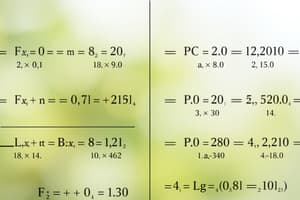Podcast
Questions and Answers
What is the taxonomic rank that has the suffix '-phyta'?
What is the taxonomic rank that has the suffix '-phyta'?
- Kingdom
- Phylum (correct)
- Order
- Class
Which of the following species is NOT found in the Philippines?
Which of the following species is NOT found in the Philippines?
- Mangifera indica
- Pithecophaga jefferyi
- Drosophila melanogaster
- Mus musculus (correct)
What is the domain of modern humans?
What is the domain of modern humans?
- Eukarya (correct)
- Archaea
- Protista
- Bacteria
Which suffix is commonly used for family rank in animal classification?
Which suffix is commonly used for family rank in animal classification?
What is the genus of the Philippine macaque?
What is the genus of the Philippine macaque?
Which of the following is a model organism?
Which of the following is a model organism?
What is the taxonomic rank that has no commonly used suffix?
What is the taxonomic rank that has no commonly used suffix?
Which of the following species is a type of fruit fly?
Which of the following species is a type of fruit fly?
What is the term for the genetic makeup of an organism?
What is the term for the genetic makeup of an organism?
What is the term for an allele that has no noticeable effect on an organism's appearance?
What is the term for an allele that has no noticeable effect on an organism's appearance?
What is the term for a gene that has two different alleles?
What is the term for a gene that has two different alleles?
What is the term for the crossing of two true-breeding varieties?
What is the term for the crossing of two true-breeding varieties?
What is the term for the phenomenon where the expression of a gene at one locus alters that of a gene at another locus?
What is the term for the phenomenon where the expression of a gene at one locus alters that of a gene at another locus?
What is the term for an organism that is heterozygous for two particular characters being followed in a cross?
What is the term for an organism that is heterozygous for two particular characters being followed in a cross?
What suffix is used to denote a polyatomic ion with several oxygen atoms?
What suffix is used to denote a polyatomic ion with several oxygen atoms?
What is the correct name for the iron ion with a charge of 2+?
What is the correct name for the iron ion with a charge of 2+?
Which of the following is an example of an empirical formula?
Which of the following is an example of an empirical formula?
What is the correct suffix for a monoatomic non-metal ion?
What is the correct suffix for a monoatomic non-metal ion?
Which of the following transition metal ions has a larger charge?
Which of the following transition metal ions has a larger charge?
What is the correct name for a polyatomic ion with less oxygen atoms?
What is the correct name for a polyatomic ion with less oxygen atoms?
What is the correct suffix for a transition metal ion with a smaller charge?
What is the correct suffix for a transition metal ion with a smaller charge?
Which of the following is an example of a molecular formula?
Which of the following is an example of a molecular formula?
Flashcards are hidden until you start studying
Study Notes
Stoichiometry
- Chemical formulas can be molecular or empirical
- Molecular formula: actual number of atoms in a molecule, e.g. C2H6
- Empirical formula: simplest whole number ratio of atoms, e.g. CH3
Nomenclature
- Ionic compounds:
- Monoatomic non-metal: -ide
- Polyatomic:
- Several O atoms: -ate
- Less O atoms: -ite
- Transition metals:
- Smaller charge: -ous
- Larger charge: -ic
- Example: Fe2+ is ferrous, Fe3+ is ferric
Quantum Numbers
- Describe an electron and serve as solutions to the Schrödinger wave equation
- n (principal/shell): distance of orbital from nucleus, possible values: 1, 2, 3, 4, 5
- ℓ (azimuthal/angular shape of orbital subrange): possible values: 0, n-1
- ml (magnetic): orientation of orbitals, possible values: -l, +l
- ms (spin): direction of magnetic spin, possible values: ½, -½
Subshells and Shells
- Subshells:
- s: 1 orbital, 2 electrons
- p: 3 orbitals, 6 electrons
- d: 5 orbitals, 10 electrons
- f: 7 orbitals, 14 electrons
- g: 9 orbitals, 18 electrons
- Shells:
- 1st shell: 1s, 2 electrons
- 2nd shell: 2s, 2p, 8 electrons
- 3rd shell: 3s, 3p, 3d, 18 electrons
- 4th shell: 4s, 4p, 4d, 4f, 32 electrons
Taxonomic Ranking
- Mnemonic: Dear King Philip Came Over For Great Spaghetti
- Taxonomic ranks from general to specific:
- Domain: Eukarya
- Kingdom: Animalia
- Phylum: Chordata
- Class: Mammalia
- Order: Carnivora
- Family: Hominidae
- Genus: Homo
- Species: Homo sapiens
Species to Remember
- Found in the Philippines:
- Pithecophaga jefferyi (Philippine eagle)
- Bubalus mindorensis (tamaraw)
- Bubalus bubalis (carabao/water buffalo)
- Jasminum sambac (sampaguita)
- Musa textilis (abaca)
- Musa squamosa (banana)
- Passer montanus (maya bird)
- Chanos chanos (bangus)
- Mangifera indica (mango)
- Pterocarpus indicus (narra)
- Macaca fascicularis (Philippine macaque)
- Oryza sativa (rice)
- Model organisms:
- Drosophila melanogaster (fruit fly)
- Escherichia coli
- Saccharomyces cerevisiae (baker's yeast)
- Danio rerio (zebrafish)
- Mus musculus (house mouse)
Genetics
- True-breeding: produces only the same variety as the parent
- Hybridization: crossing of two true-breeding varieties
- P generation: parent
- F1 generation: first filial
- Allele: alternative versions of a gene
- Dominant: determines the organism's appearance
- Recessive: no noticeable effect on the organism's appearance
- Homozygous: gene with a pair of identical alleles
- Heterozygous: gene with two different alleles
- Phenotype: an organism's appearance or observable traits
- Genotype: genetic makeup
- Monohybrids: heterozygous for one particular character
- Dihybrids: heterozygous for two particular characters
- Pleiotropy: having multiple phenotypic effects, especially in alleles
- Epistasis: phenotypic expression of a gene at one locus alters that of a gene at a second locus
- Quantitative characters: vary in the population in gradations along a continuum
Studying That Suits You
Use AI to generate personalized quizzes and flashcards to suit your learning preferences.




